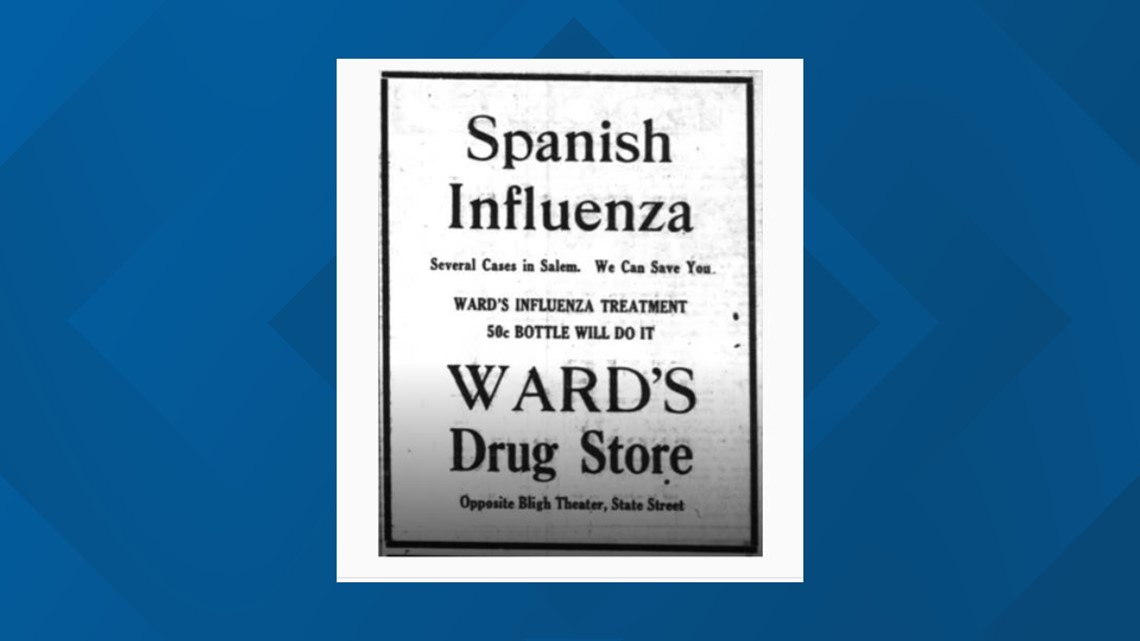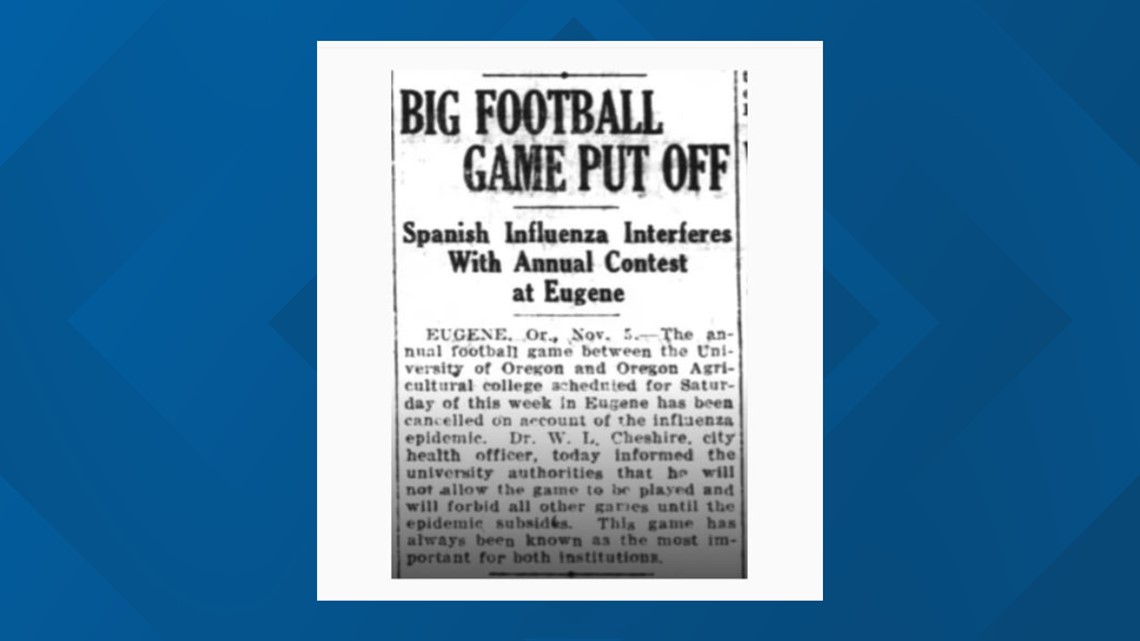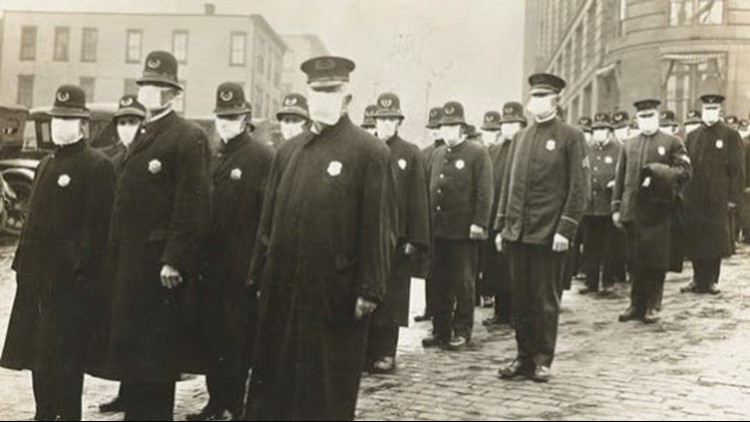SALEM, Oregon — The 1918 flu pandemic was more than three times as deadly for Oregonians than World War I.
Service records show 44,166 fought in the war and 1,030 lost their lives.
Health records show 48,146 caught the flu and 3,675 died.
The deadliest pandemic in modern history came to be known as the Spanish flu, although Spain was mistakenly assumed to be ground zero. Illnesses and deaths were highly publicized in Spain, neutral during the war, but censored in other nations to avoid affecting morale.
While there's no consensus regarding where the disease originated, the role of the war in its rapid spread is indisputable. In the United States, it was directly traced to troop movements by train and ship.
The first reported case in the Pacific Northwest came in mid-September after a trainload of sick sailors arrived at the Puget Sound Navy Yard from Philadelphia. Around the same time, an outbreak cropped up at nearby Camp Lewis after a trainload of soldiers arrived from Boston, a hot zone because of it's a principal shipping port.
Soon after, the virus spread to Fort Stevens near Astoria.
"At last," the Morning Astorian reported Oct. 2, "Oregon has been infected with the plague."
Some of the same prevention methods we've seen implemented by public health officials today for COVID-19 were urged back then, such as washing hands and social distancing, although that term was not used a century ago.
Schools were closed then, too, and public gatherings banned.
The Spanish flu still infected an estimated 500 million people, nearly one-third of the world's population, and eventually claimed more than 50 million lives.
In the United States, about 675,000 died.
Oregon fared better than many states and Salem better than Portland.
Here's what we learned from our newspaper archives about the local reaction and impact of the Spanish flu:
Chemawa is impacted first
Spanish influenza reports first appeared in The Oregon Statesman in September, with headlines sprinkled on inside pages about the spread at Army camps in Massachusetts, Virginia and New York.
An Oct. 1 report out of Washington, D.C., revealed just how fast it could spread: 20,000 new cases in camps over a 48-hour period.
The next day, another report, and 14,000 new cases in camps.
Two days later, 12,000-plus new cases.
In that same Oct. 4 edition of the Statesman, locals could easily have missed a short story on Page 8 with the headline "Civilians now succumbing to dread disease." It reported how the Spanish flu was now in 43 states and particularly prevalent on the Atlantic seaboard and Gulf Coast.
Portland was the first city in Oregon to act. Its city health officer made a public announcement in the Oct. 5 Oregonian requiring theater owners to eject all persons who coughed or sneezed.
State health officials prepared slides to distribute to theaters throughout the state with advice on preventive measures. There was no internet to fast track media reports and no social media.
Within a week, Portland closed its schools, theaters, pool halls and bowling alleys. Lodge meetings, club activities and parades were banned.
Salem didn't immediately follow Portland's lead, even as makeshift hospitals were erected overnight by its neighbor to the north, including at Benson Polytechnic High School and Civic Auditorium.
The Statesman reported Oct. 9 the disease had pervaded Chemawa Indian School but called it isolated, with local officials still claiming the epidemic hadn't yet reached Salem.
A special influenza committee meeting called by order of the American Red Cross declared public meeting spaces would close if any case appeared. From that meeting, it was reported "all speakers urged upon the gatherers that there is no need for hysteria over the mention of influenza and that every sneezer need not be accused of having it."
The situation changed quickly, though, much like we've seen with the current pandemic.
Salem bans public gatherings
An order from then-Salem Mayor Walter Keyes was issued on Oct. 12 to close "schools and other places of amusement." Shockingly, the news didn't even make Page 1 in the next-day's paper.
Churches, lodges, theaters, dances and "public gatherings of every kind and character" were included the order.
Dallas, Mt. Angel and Silverton were among nearby towns that would eventually shut down, too. Mt. Angel was quick to lift its ban on public gatherings, though, announcing its flu cases were contained to one family.
"Mt. Angel is out from under the Spanish flu," a columnist wrote in the Oct. 23 Statesman. "That is Salem's great ambition."
Institutions were hardest hit in Salem.
Chemawa was put under quarantine with more than a third of its 500 students suffering from influenza. By Oct. 30, there were 16 deaths at the school.
At least 90 cases of the flu were reported at the Oregon State Training School, the boys reform school later moved from Salem to Woodburn and eventually renamed McLaren.
The Oregon State Penitentiary had at least 150 cases and at least seven inmates died.
No visitors were allowed at the Oregon State Hospital, where there were a couple dozen cases but no reported deaths.
What made the Spanish flu especially terrifying was it struck down otherwise healthy adults under the age of 40. Influenza deaths previously had been limited to children, the elderly or already weakened patients.
Multiple obituaries in the Statesman confirmed 20-some-year-olds such as Harlan Hoffman were dying of the Spanish flu.
Hoffman was just three years out of Salem high school and enlisted in the student army training corps at Willamette University when he died at a local hospital of "influenza which terminated in pneumonia."
Patients get primitive treatment
Health care systems and medical personnel worldwide were overwhelmed by the pandemic, again, much like we're seeing today.
Many U.S. communities experienced a shortage of nurses because large numbers were deployed to military camps. Some gave their lives battling the disease, including Ora Cavitt, a nurse from Salem.
Cavitt was widely known in professional and society circles, having grown up in Polk County, graduated from Salem High School and done training at Willamette Sanitarium. She died at Camp Lewis just three weeks after arriving to care for infected soldiers.
A serum and some vaccines were developed and used during the pandemic, with contradictory claims of success. Homespun remedies reportedly tried included ingesting cinnamon, drinking wine and drinking beef broth.
An unspecified treatment was advertised in the Statesman by Ward’s Drug Store on State Street: "Several Cases in Salem. We Can Save You. WARD'S INFLUENZA TREATMENT. 50c BOTTLE WILL DO IT."


Pneumonia was a frequent complication of the Spanish flu, similar to what's happening with the new coronavirus. But in 1918, there were no antibiotics. Providing fluids and keeping patients warm were the primary treatment options.
Pneumonia jackets, which sometimes included rubber tubing that circulated hot water, were used to warm a person's chest. Camphor oil chest rubs and various types of throat spray also were used to treat patients.
Red Cross volunteers helped make supplies during the pandemic, including pneumonia jackets and face masks. A photo of a couple dozen Seattle police officers wearing masks made by the local Red Cross chapter is in the National Archives.
In Salem, there doesn't appear to have been a shortage of masks, a huge concern today inspiring community members who can sew to rush to the aid of local health providers.
The Statesman reported on Oct. 25, 1918 that three gauze masks were distributed to each of Willamette's army training corps students, with instructions to wear one when in contact with others, including in barracks and classrooms.
Outbreaks recur after ban lifted
The influenza spread was on the decline by the end of October, when it was reported Salem had 184 cases and 16 deaths, not including Chemawa and state institutions.
Officials believed the worst was over but made no effort open the town, noting the flu broke out a second time in larger cities that did so too soon.
Would-be voters in the upcoming election were encouraged to wear masks and not linger at polling stations to keep crowds to a minimum.
The annual football game between the University of Oregon and Oregon State — what we know today as the Civil War — was postponed.


The month-long ban was lifted and schools reopened Nov. 11. Certain restrictions were maintained, although no details were reported.
The Statesman did report that the school board would look into ways to offset days lost, including reducing vacations (just one day for Thanksgiving and a week instead of two for Christmas) and abandoning standard tests. Many of us parents wonder what Salem-Keizer Public Schools and other local districts will do after a longer shutdown.
In Silverton, a quarantine was lifted on Nov. 23, with school officials considering lengthening school hours and holding classes on Saturdays. Less than two weeks later, the town was back under quarantine with more serious cases reported.
Recurrent outbreaks popped up in December and would continue through 1919.
In Salem, 50 homes were under quarantine on Dec. 29, and the mayor issued a proclamation banning public dances in advance of New Year’s Eve. Two days later, the number of quarantined homes spiked to 125.
A report from the city health department in early January confirmed there were 32 deaths by flu in 1918, more than any other disease that year.
This article was originally published by the Salem Statesman Journal, one of more than a dozen news organizations throughout the state sharing their coverage of the novel coronavirus outbreak to help inform Oregonians about this evolving health issue.



